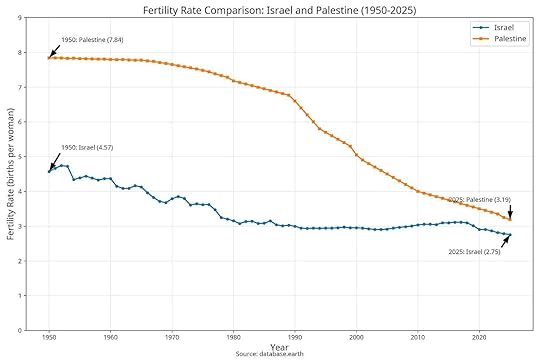Gaza: The Tragedy that Could Have Been Avoided

The fertility rate (number of children per woman) for the Israeli and Palestinian populations. The difference was large in the 1950s, when nearly two Palestinian children were born for each Israeli one. But now the gap is closing, and the trend prefigures a near future when the fertility of both populations will be insufficient to replace the natural death rate. It is the “population transition” taking place everywhere in the world. As a consequence, the population of the region is going to peak and decline, most likely before the end of this century, making the problem of land availability much less dramatic than it is usually seen. Data from “database.earth.” Plot created by “Manus” AI.
It is said that generals are always ready to fight the last war. It is even worse for politicians, who often address problems that no longer exist. This outdated thinking persists in the current conflict in the Israel/Palestine region, which Mr. Netanyahu likened to the biblical Amalekites, who attacked the Israelites during the Exodus and were later ordered destroyed by God (1 Samuel 15). In our times, we see God as benevolent and merciful, finding it strange that He could command the destruction of a whole population. Yet, the Amalek story is not exceptional in human history, where violence over resources has been common, as I explore in my book Exterminations.

Large-scale exterminations have been a constant in human history. Fights were mostly about land and resources, and when a population that occupied a territory couldn’t offer significant resistance, it was often expelled, enslaved, or exterminated by more powerful neighbors. Modern exterminations are way larger than the Amalek episode described in the Bible. Think of the American Natives in the United States: we are talking of millions, perhaps tens of millions, of people killed, and there are many more recent examples. In my book, I note how exterminations became progressively more common as the world became more crowded.
Palestine, intended as a geographical region, is especially prone to violence, being a bridge between Asia and Africa; a forced passage for armies and populations. Not for nothing, the first large battle for which we have historical records was fought in this region, near the city of Megiddo. We remember it with the name of “Armageddon.” So, the war that pitted the Amalekites against the Israelites in Biblical times is just one of the many that took place in the area.
We could see the tragedy happening in Gaza as a continuation of ancient trends: fighting for land in a limited space. That explains, although it does not justify, the violence of the current conflict. But something is happening in the world that could change everything. It is the demographic transition created by a rapid global fertility decline. The Malthusian assumption that a population would always keep growing until stopped by famines, plagues, or wars turns out to be untenable nowadays.
Many regions of the world are not only seeing their fertility rate plummeting below the replacement level, but also the decline of their total population. Practically all Western countries are already in this stage, just as several Asian ones, including China. You can read more in a previous post of mine on this blog.
How about Israel and Palestine? The trend is the same, although it has not yet arrived at the stage of population decline typical of industrialized countries. As I show in the plot at the beginning of this post, the fertility rate of both Palestinians and Israelis has been plummeting during the past few decades. In the 1950s, the Palestinians were said to be waging a “crib war,” trying to outbreed the Jewish people. But their fertility rate was not higher than that typical of rural populations at the time. In any case, now the gap is closing, and in a few years, both populations may go below the threshold of 2.1 children per woman, the minimum needed to compensate for the natural death rate.
Will the fertility decline continue in the future? Most likely, yes. The reasons that make it unavoidable are discussed in detail in my upcoming book “The End of Population Growth.” The trend is usually attributed to urbanization, with the correlated tendency of women to access higher education and high-level jobs. It may also be due to pollution and stress affecting the human endocrine system, reducing fertility for biochemical reasons.
In addition, the Israel/Palestine region has specific problems due to the high population density and the geographical location. One is a high level of pollution, and the war is worsening things even more. Then, global warming is hitting the region hard, causing an increase in temperatures larger than the average in the world, already 1.5°C above pre-industrial levels, and the war is surely not helping in mitigating the climate situation. These factors are putting additional strain on population growth and may hasten the fertility decline.
The official statistical projections are predicting that both populations will continue to grow throughout the current century, but the turning point might arrive much sooner. Typically, projections based on “system dynamics” (the tool used for the “Limits to Growth” study of 1972) generate the start of population decline 3-4 decades earlier than purely statistical models. Hence, although there are no specific studies for the region, “peak population” could arrive as early as 2050, or even earlier.
So, is it still necessary to fight for land in the Israel/Palestine region? Right now, we have two growing populations desperately fighting to gather enough space in a limited strip of land. But if we look a little further in the future, we see that the overpopulation problem in the region is not as pressing as it was perceived to be at the time of the “crib war.” And it will become less and less pressing with time, as the demographic transition takes place. That would not affect the ideological, social, and religious factors involved in the conflict, but it is clear that the times of Amalek are gone. We are entering a new era in which conflicts for land will be obsolete. Besides, it is simply insane to waste precious resources in a war when these resources would be desperately needed to create infrastructure to mitigate the effects of further global warming in the region. The tragedy of Gaza could have been avoided if people could reason instead of acting out of fear and hatred.
But so is the way the human mind works, and it seems that we are in the hands of people who think they still live at the time of Amalek, perhaps three thousand years ago. They should read their Bible better; “They sow the wind and reap the whirlwind.” – Hosea 8:7



